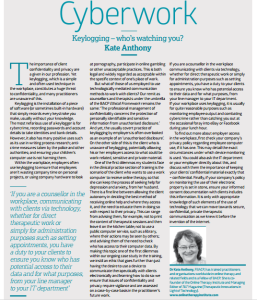I’ve been thinking about both my contributors to TILT Magazine and my own role as a columnist recently. This was inspired by the departure of my good colleague Anne Stokes over at TILT Towers, who has been with us from the inaugural issue right up to the present day – that’s 20 columns submitted for our readers pleasure and education (or, to look at it differently, nearly a whopping 20,000 words!). Anne’s topic was CyberSupervision, and I doubt we could have found a better UK expert to offer her words of wisdom (not to mention her being a pleasure to work with and her ability to meet deadlines like no other author I have come across in my time as Editor!).
Anne is handing her baton to another of our dear colleagues after the Winter 2014 issue of TILT to Cedric Speyer, another fine example of a CyberSupervisor we are very lucky to have on board, and perhaps with a very different style and passion – so while I am sad to say farewell to Anne, I’m also excited to welcome Cedric.
Our columnists receive no financial gain from their contributions, and nor have I over my years contributing regular columns for other editors. I do try to be a regular columnist for only one publication at a time because of this (otherwise I can’t afford to feed the cat), but what is it about contributing our expertise to a wider audience that keeps us doing it for free?
Here are some thoughts:
We reach new audiences
My current regular column is with the British Association of Counselling and Psychotherapy’s Workplace Division ( download it now! 13559_cyberwork CAW Autumn 2014). Not only does my work on Cyberculture and the impact of online services reach a new audience by doing this, I reach people who actively pay for a subscription and so are invested in reading the Journal. Sure, they may skip over my part in it, but I am sure that the topic will surface in some part of their work one day and cause them to think “oh! I can find out more about this can’t I? – my journal covers it in every edition!” I also receive a .pdf for my own distribution, as do all our columnists in TILT.
We receive new areas in which to market
Every columnist with a good editor will have a chance to provide the context in which they work in return for their wise words. My by-line contains details of who I am, what I offer (and where), and how to get hold of me. Readers of the journal are those involved in or contributing to the emotional and psychological health of people in organisations, including workplace counsellors, trainers, team leaders and welfare staff, occupational psychologists, HR managers and those with an interest in employee counselling services and skills. How else could I each these people without investing in financial ways of marketing? And if your column makes it to the online version of the journal – as mine does – then that’s a whole new way of increasing your SEO!
We add to our publication lists
We all have a Curriculum Vitae or Résumé to maintain and our columns do just that. Keep your links fresh from your up-to-date list of publications online and you have a handy resource to disseminate your work without resorting to a scanner or – dare I say it – a photocopier (that is SO 2008!).
Finally – you keep the Editors of the world very happy!
Really you do! My role as co-Managing Editor of TILT Magazine is a labour of love, for all the reasons I outlined in an earlier post – and my regular columnists make my job 100 times better just by being willing and able to contribute with a cheery email when sending their work. I am terrible with deadlines, and yet I rarely hear a peep of complaint about that! So thank you to you all – past, present and future – for keeping me and my readers happier in our work!
🙂


